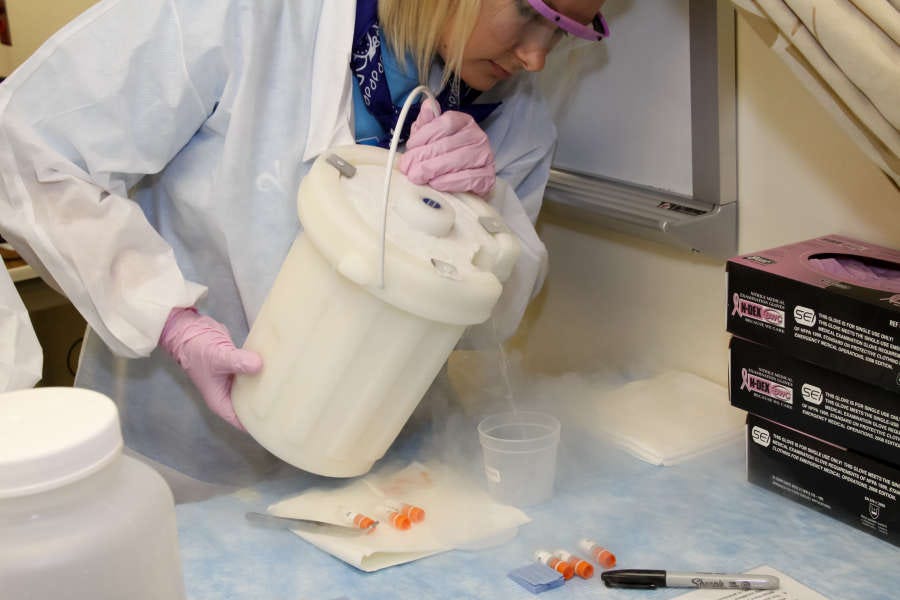LifeOmic Unlocks Komen’s Genomic Data Power
 Prior to the partnership
Prior to the partnership
Subscriber Benefit
As a subscriber you can listen to articles at work, in the car, or while you work out. Subscribe NowLeaders of the Komen Tissue Bank at the Indiana University Simon Cancer, the only repository in the world for normal breast tissue, say the organization is taking its data “to a whole new level.” The bank, founded in Indianapolis in 2007, and software company LifeOmic, based in the same city, are combining forces to unleash the power of genomic data in breast cancer research—not just in Indiana, but around the world.
LifeOmic founder and Chief Executive Officer Dr. Don Brown says the ability to sequence the DNA of cancers has “changed the whole game” of how doctors treat the disease. Rather than viewing cancer as a “mystical set of cells growing out of control,” genomic data is helping researchers understand what’s driving each individual’s cancer. Brown says the disease is now viewed as being “very custom”—different from person to person.
“This genomic data is wonderful and exciting, but it’s big data, because every one of our cells has 3 billion letters—3 billion base pairs—of DNA,” says Brown, who is also a serial entrepreneur and Indiana tech giant. “So when we sequence somebody—whether their germ line sequence they were born with or their cancer—it’s about 100 gigabytes of information. That’s huge amounts of information, and there’s no way individual doctors or researchers can deal with that. What’s needed are big data tools that can store this information in cloud systems, where there really are no limitations. Then, [they can] use different sorts of visualization tools to be able to look in and see what’s going on.”
LifeOmic says it has created that capability with its Precision Health Cloud (PHC), which the company has built over several years working with the Indiana University School of Medicine (IUSM) and the university’s Precision Health Initiative; IU has a 1.5% ownership interest in LifeOmic and its subsidiaries. LifeOmic says its PHC has been in use at major medical and cancer centers for several years.
“The Komen Tissue Bank can use [the PHC] now and load all this data; not just DNA sequence, but also pictures of cancers, pictures of cells, and patient electronic health record information. It’s really combining all of this information together that allows researchers to gain new insights—to run the different sorts of analytical tools that are available to drive meaning,” says Brown. “This is a whole new capability for [the Komen Tissue Bank]. Up to this point, the bank has been concerned with keeping tissue samples, keeping track of the person each sample came from and taking images of those tissues, but there was no genomic component at all, so that whole piece was missing.”
All of this uploaded, aggregated and indexed information forms the Virtual Tissue Bank—now even more robust with genomic data—which can be accessed by scientists around the world.
“If I’m a researcher in Timbuktu, and I have data from a different repository, now I can look at Komen data sets—and without ever physically entering a lab—do an experiment and draw conclusions,” says Dr. Anna Maria Storniolo, the IUSM Andrew and Peggy Thomson Professor of Hematology Oncology and IU Simon Cancer Center member.
Storniolo says the Virtual Tissue Bank unleashes “incredible power across the globe,” and will speed discoveries that could lead to better screening, treatments, and “everything to do with breast cancer.”
“[The Komen Tissue Bank] has now been approached by multiple companies in artificial intelligence to use AI techniques to try to do pattern recognition across our pictures of 5,600 [Komen tissue] specimens under the microscope and find answers about risk, et cetera,” says Storniolo. “Things you would never even imagine in a million years, but because of the power LifeOmic gives us to put it all in one place in such a way that it’s accessible, now those types of analyses are able to be done.”
Storniolo believes the partnership, ultimately, means researchers can maximize the data “we’re getting from the very, very precious samples” women volunteers are donating to the bank. Storniolo says when the Komen Tissue Bank began about 12 years ago, “I don’t think these women had any concept how important all of this would end up being.”
“I think they knew it was important in 2010 terms, but as we learn more and get deeper and deeper into the genetic level—I think they will be blown away and startled by the power of their gift,” says Storniolo. “When the code to breast cancer is cracked—and it’s not that far away—I really think the women of Indiana will be able to pat themselves on the back and say, ‘We had a lot to do with that.’ And they should be proud of it, because they did. This is all about them; it’s not about Komen or LifeOmic, it’s about the women who took a risk and gave of themselves.”
Brown says cancer research is making “tremendous progress across the board,” and much of it is happening in Indiana.
Brown says LifeOmic provides new genomic data capabilities for the Komen Tissue Bank, which will help identify trends, associations and drivers of breast cancer.
Storniolo says the new partnership enables the Komen Tissue Bank to maximize its data.
